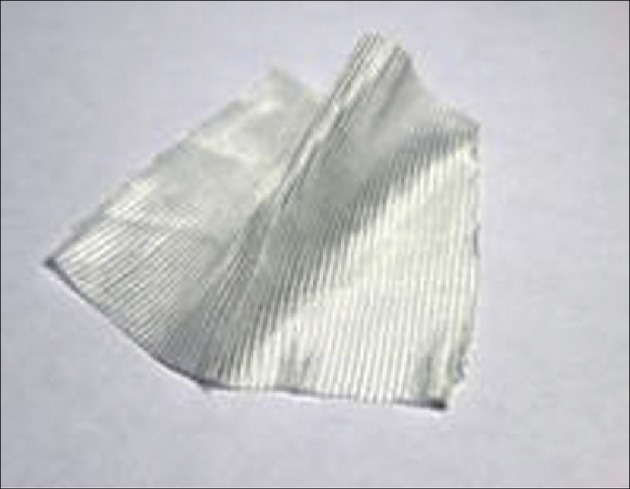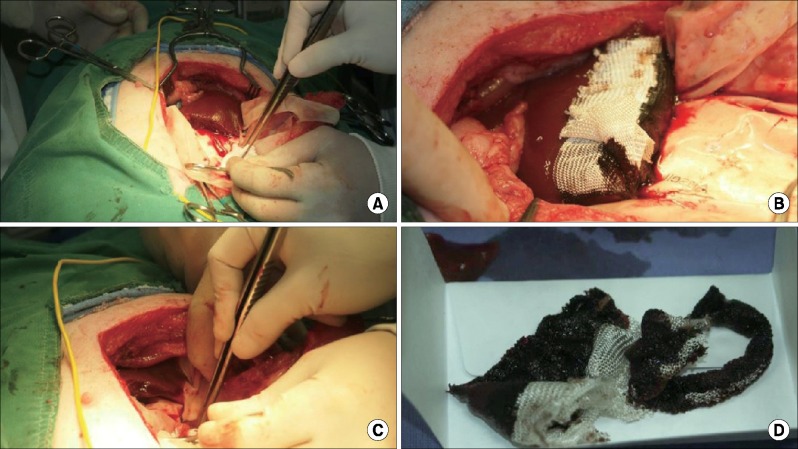Korean J Hepatobiliary Pancreat Surg.
2016 Aug;20(3):102-109. 10.14701/kjhbps.2016.20.3.102.
Efficacy evaluation of SurgiGuard® in partially hepatectomized pigs
- Affiliations
-
- 1Department of Hepatobiliary and Pancreatic Surgery, Severance Hospital, Yonsei University College of Medicine, Seoul, Korea. KSKIM88@yuhs.ac
- 2Department of Quality Assurance, Samyang Biopharmaceuticals Corporation, Daejeon, Korea.
- 3Department of Biology and Clinical Pharmacology, Samyang Biopharmaceuticals Corporation, Daejeon, Korea.
- KMID: 2351296
- DOI: http://doi.org/10.14701/kjhbps.2016.20.3.102
Abstract
- BACKGROUNDS/AIMS
This study evaluated the hemostatic effects of a novel oxidized regenerated cellulose, SurgiGuard®, during liver surgery, using a reproducible and clinically relevant animal model.
METHODS
Fifteen mini-pigs underwent left partial hepatectomy. They were randomized to treatment of the resected surface with SurgiGuard® (Group C [test], n=5), Surgicel® (Group B [reference], n=5), or nothing (Group A [control], n=5). Blood loss was measured 5, 7 and 9 min after resection. Time to hemostasis was recorded. Mini-pigs were necropsied 4 or 6 weeks postoperatively to evaluate toxicity changes and material dissolution.
RESULTS
The median resected liver weight was 2.13 g (2.02-2.20) in control group, 2.04 g (2.01-2.13) in reference group, and 2.01 g (1.99-2.12) in test group (p=0.024). Median total blood loss was 57.18 g (52.02-59.54) in control group, 32.52 g (27.66-35.10) in reference group, and 35.52 g (25.70-38.71) in test group (p=0.008). Blood loss at 0-5 minutes and 7-9 minutes was significantly different between groups (p=0.009 and p=0.006, respectively). At necropsy, no hematomas, granulomas, or adhesions were noted in any group. Histopathological analysis revealed no changes suggesting toxicity related to SurgiGuard®.
CONCLUSIONS
SurgiGuard® is as effective as Surgicel® in achieving hemostasis after porcine partial liver resection.
Figure
Reference
-
1. Wei AC, Tung-Ping Poon R, Fan ST, Wong J. Risk factors for perioperative morbidity and mortality after extended hepatectomy for hepatocellular carcinoma. Br J Surg. 2003; 90:33–41. PMID: 12520572.
Article2. Uranüs S, Mischinger HJ, Pfeifer J, Kronberger L Jr, Rabl H, Werkgartner G, et al. Hemostatic methods for the management of spleen and liver injuries. World J Surg. 1996; 20:1107–1111. PMID: 8798373.
Article3. Seyednejad H, Imani M, Jamieson T, Seifalian AM. Topical haemostatic agents. Br J Surg. 2008; 95:1197–1225. PMID: 18763249.
Article4. Muench TR, Kong W, Harmon AM. The performance of a hemostatic agent based on oxidized regenerated cellulose--polyglactin 910 composite in a liver defect model in immunocompetent and athymic rats. Biomaterials. 2010; 31:3649–3656. PMID: 20144845.5. Kanko M, Liman T, Topcu S. A low-cost and simple method to stop intraoperative leakage-type bleeding: use of the vancomycin-oxidized regenerated cellulose (ORC) sandwich. J Invest Surg. 2006; 19:323–327. PMID: 16966211.
Article6. Frantz VK. bsorbable cotton, paper and gauze: (oxidized cellulose). Ann Surg. 1943; 118:116–126. PMID: 17858245.7. Simo KA, Hanna EM, Imagawa DK, Iannitti DA. Hemostatic agents in hepatobiliary and pancreas surgery: a review of the literature and critical evaluation of a novel carrier-bound fibrin sealant (TachoSil). ISRN Surg. 2012; 2012:729086. PMID: 23029624.
Article8. Chvapil M, Owen JA, DeYoung DW. A standardized animal model for evaluation of hemostatic effectiveness of various materials. J Trauma. 1983; 23:1042–1047. PMID: 6655749.
Article9. Blair SD, Backhouse CM, Harper R, Matthews J, McCollum CN. Comparison of absorbable materials for surgical haemostasis. Br J Surg. 1988; 75:969–971. PMID: 3219544.
Article10. Frantz VK, Clarke HT, Lattes R. Hemostasis with absorbable gauze (oxidized cellulose). Ann Surg. 1944; 120:181–198. PMID: 17858482.11. Wright GF, Tyson RR. Oxidized regenerated cellulose for hepatic hemostasis. Arch Surg. 1963; 87:669–672. PMID: 14056251.
Article12. Velázquez-Aviña J, Mönkemüller K, Sakai P, Sulbaran M, Chávez-Vargas C, Montalvo Javé E, et al. Hemostatic effect of oxidized regenerated cellulose in an experimental gastric mucosal resection model. Endoscopy. 2014; 46:878–882. PMID: 25225961.
Article13. Scher KS, Coil JA Jr. Effects of oxidized cellulose and microfibrillar collagen on infection. Surgery. 1982; 91:301–304. PMID: 7058512.14. Tomizawa Y. Clinical benefits and risk analysis of topical hemostats: a review. J Artif Organs. 2005; 8:137–142. PMID: 16235029.
Article15. Dineen P. The effect of oxidized regenerated cellulose on experimental intravascular infection. Surgery. 1977; 82:576–579. PMID: 918847.16. Larsson B, Nisell H, Granberg I. Surgicel--an absorbable hemostatic material--in prevention of peritoneal adhesions in rats. Acta Chir Scand. 1978; 144:375–378. PMID: 735674.17. Raftery AT. Absorbable haemostatic materials and intraperitoneal adhesion formation. Br J Surg. 1980; 67:57–58. PMID: 7357246.
Article18. Prevention of postsurgical adhesions by INTERCEED(TC7), an absorbable adhesion barrier: a prospective randomized multicenter clinical study. INTERCEED(TC7) Adhesion Barrier Study Group. Fertil Steril. 1989; 51:933–938. PMID: 2524407.19. Ahmad G, O'Flynn H, Hindocha A, Watson A. Barrier agents for adhesion prevention after gynaecological surgery. Cochrane Database Syst Rev. 2015; (4):CD000475. PMID: 25924805.
Article20. Katti DS, Lakshmi S, Langer R, Laurencin CT. Toxicity, biodegradation and elimination of polyanhydrides. Adv Drug Deliv Rev. 2002; 54:933–961. PMID: 12384316.
Article21. Wada E, Yonenobu K, Ebara S, Kuwahara O, Ono K. Epidural migration of hemostatic agents as a cause of postthoracotomy paraplegia. Report of two cases. J Neurosurg. 1993; 78:658–660. PMID: 8450341.22. Behbehani S, Tulandi T. Oxidized regenerated cellulose imitating pelvic abscess. Obstet Gynecol. 2013; 121(2 Pt 2 Suppl 1):447–449. PMID: 23344404.
- Full Text Links
- Actions
-
Cited
- CITED
-
- Close
- Share
- Similar articles
-
- Efficacy of Oxidized Regenerated Cellulose, SurgiGuard®, in Porcine Surgery
- Efficacy of bivalent vaccines of porcine circovirus type 2 and Mycoplasma hyopneumoniae in specific pathogen-free pigs challenged with porcine circovirus type 2d
- Pattern of Oral Desensitization in DNCB Presensitized Guinea Pigs
- The Comparison of Cellular Immune Reactions in Mycobacterium Tuberculosis-Inoculated Guinea Pigs and Rabbits
- Genetic identification and serological evaluation of commercial inactivated foot-and-mouth disease virus vaccine in pigs



